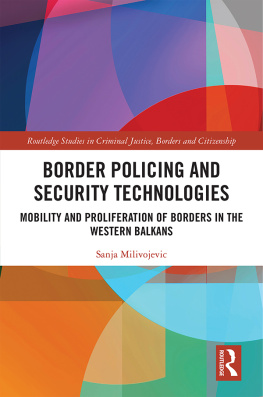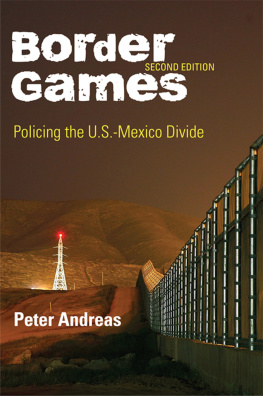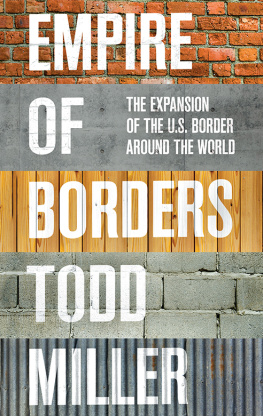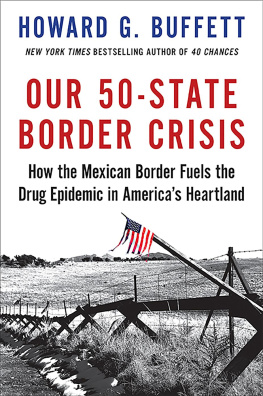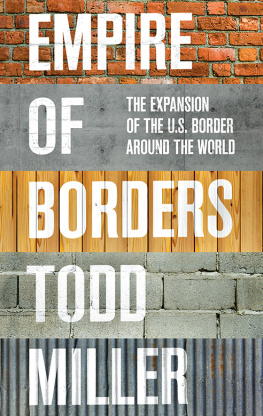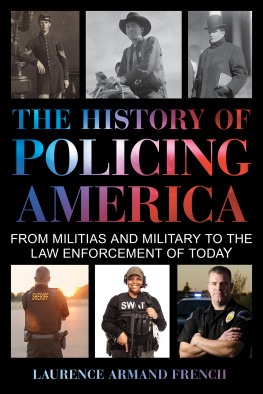Border Policing
A History of Enforcement and Evasion in North America
EDITED BY HOLLY M. KARIBO AND GEORGE T. DAZ

University of Texas Press
Austin
Copyright 2020 by the University of Texas Press
A Border without Guards: First Nations and the Enforcement of National Space by Benjamin Hoy, copyright 2014 by the Canadian Historical Association/La Socit historique du Canada
All rights reserved
First edition, 2020
Requests for permission to reproduce material from this work should be sent to:
Permissions
University of Texas Press
P. O. Box 7819
Austin, TX 78713-7819
utpress.utexas.edu/rp-form
Library of Congress Cataloging-in-Publication Data
Names: Karibo, Holly M., editor. | Daz, George T., editor.
Title: Border policing : a history of enforcement and evasion in North America / [edited by] Holly M. Karibo, George T. Daz.
Description: First. | Austin : University of Texas Press, 2020. | Includes bibliographical references and index.
Identifiers: LCCN 2019024365 (print) | LCCN 2019024366 (ebook)
ISBN 978-1-4773-2067-9 (cloth)
ISBN 978-1-4773-2128-7 (pbk.)
ISBN 978-1-4773-2068-6 (library ebook)
ISBN 978-1-4773-2069-3 (non-library ebook)
Subjects: LCSH: Border patrolsNorth AmericaHistory. | Law enforcementMexican-American Border RegionHistory. | Law enforcementCanadian-American Border RegionHistory. | BorderlandsUnited StatesHistory. | Immigration enforcementUnited StatesHistory. | SmugglingUnited StatesHistory. | Border securityUnited StatesHistory.
Classification: LCC HV8138 .B585 2020 (print) | LCC HV8138 (ebook) | DDC 363.28/5097dc23
LC record available at https://lccn.loc.gov/2019024365
LC ebook record available at https://lccn.loc.gov/2019024366
doi:10.7560/320679
Contents
ELAINE CAREY AND ANDRAE MARAK
HOLLY M. KARIBO AND GEORGE T. DAZ
EDWARD J. MARTIN
LUIS ALBERTO GARCA
BENJAMIN HOY
MARA DE JESS DUARTE
THOMAS A. KLUG
JAMES DUPREE
MIGUEL A. LEVARIO
LISA D. BARNETT
CAROLINA MONSIVIS
HOLLY M. KARIBO
JENSEN BRANSCOMBE
DEVIN CLANCY AND TYLER CHARTRAND
SANTIAGO IVAN GUERRA
ANITA HUIZAR-HERNNDEZ
KARL JACOBY
Abbreviations
| ACLU | American Civil Liberties Union |
| CBP | Customs and Border Protection [United States] |
| CBSA | Canadian Border Services Agency |
| DIA | Department of Indian Affairs [Canada] |
| DPS | Department of Public Safety [Texas] |
| FBN | Federal Bureau of Narcotics [United States] |
| HIDTA | High Intensity Drug Trafficking Areas [program] |
| INS | Immigration and Naturalization Service [United States] |
| LRGV | lower Rio Grande Valley |
| NCACT | National Coalition Against Contraband Tobacco |
| NWMP | North-West Mounted Police [Canada] |
| OIA | Office of Indian Affairs [United States] |
| RCMP | Royal Canadian Mounted Police |
| SQ | Sret du Qubec |
| USCCR | US Commission on Civil Rights |
Foreword
ELAINE CAREY AND ANDRAE MARAK
In front of you is Border Policing: A History of Enforcement and Evasion in North America, a collection of cutting-edge scholarship edited by two incredibly talented borderlands scholars: Holly M. Karibo and George T. Daz. The introduction, afterword, and chapters present a historical arc of increased state and nonstate capacities to police borders over two hundred years. The chapters consider the uniqueness of place, and few places are as unique or as important as borders. It is precisely along borders that leaders of nation-states advocate for sharply demarcated and solidified national cultures and legal regimes.
Borderlands, especially those of the modern United Stateswhich imposed arbitrary borders through the lands of already existing peoplesare places of immense cultural and legal overlap. For this reason, it is important that the chapters in this volume adopt a transnational approach that moves beyond localized studies of police and policing to contemplate an array of agencies and agents who engage in customs, immigration, and drug interdiction across different borders, both land and water. In examining these areas, the contributors embrace intersectionality to consider people, the colonial state, Native sovereignty, and boundary creation and border enforcement. This volume ignites a series of questions for consideration about the roles of policing in North American borderlands that are changing immigration controls, trade wars, and the decades-long drug wars (which we would argue began more than a century ago). At the same time, there has been alternating hardening and softening of borders as more items and people cross, even as some categories of people and goods are increasingly prevented from passing through borders and forced to adopt more dangerous and expensive means of crossing.
As borderlands historians have demonstrated, there is quite a bit of continuity along national divides, and we have much to learn by studying them through a historical lens. Take the most recent pressing borderlands issues as an example. Changes in technology combined with the rise of the opioid epidemic in the United States and Canada (along with ongoing drug violence and growing levels of addiction in Mexico) have altered policing and the role of police. Not only have policing objectives and practices changed; community responses have changed as well. Canadian and US health agencies have sounded the alarm regarding opioid addiction and its social and economic costs for two decades. Sheriffs and police departments in the Midwest have found that the opioid epidemic has changed their roles as jails expand to incarcerate people and to serve as early drug intervention centers. Further, first responders and police now administer naloxone, a medication that reverses an opioid overdose by blocking its effects. At the same time, police and sheriffs departments, both large and small, must purchase Narcan, the nasal spray of naloxone. With a two-dose kit costing between $130 and $140 dollars, the expense that police departments incur can be substantial.
As a sign of how the state security apparatus has extended beyond the borderlands to closer inspection internally, some police departments ask recipients of Narcan or naloxone after an overdose to sign a waiver allowing access to their cell phones. In turn, the police hand over the data to a technician to analyze social media and phone contacts. The analyst scrutinizes the social networks of the addict to uncover the supplier of the drugs. As a result, police departments have been able to create a vast database that captures local and transnational social networks of drug distribution. By understanding the hierarchy, distribution patterns, and overlapping networks, policing agents are able to place under surveillance those higher up in the network (and often across both jurisdictional and international borders). Where might the tracking of social networks eventually lead? How might suppliers respond to these new means of intervention? Would they become even flatter and less hierarchical, as drug organizations respond to interventions aimed at apprehending drug lords?
This is only one example of the ways the security state has changed policing practices. We can imagine how the mapping of social networks Still, we need to ask further questions. What does it mean to sign a waiver shortly after being treated with naloxone/Narcan for an opioid overdose? Conversely, what does it mean when police agents and police stations provide medical assistance and drug rehabilitation in areas that are starved for hospitals, rehab facilities, and early intervention? How, ultimately, have domestic policing practices become inherently transnational, reaching beyond local communities and often beyond jurisdictional bounds that traditionally limited policing activities?
Next page

